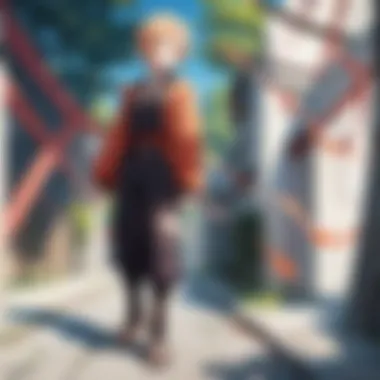An In-depth Exploration of Naruto Shippuden: Themes, Characters, and Impact


Intro
Naruto Shippuden stands as a monumental work in the world of anime, marking an evolution from its predecessor, Naruto. This series broadens its narrative scope and deepens its character studies. The complexity of its plots and emotional heft of its characters resonate with a wide audience. Its significance lies not just in its gripping storylines, but also in its exploration of profound themes such as friendship, rivalry, and the nature of sacrifice. This article serves to dissect these elements, offering insights into how Naruto Shippuden has impacted both the anime landscape and its viewers.
Series Overview
Synopsis and Premise
Naruto Shippuden picks up some time after the original Naruto series, following the titular character, Naruto Uzumaki, as he returns to his village, Konohagakure. He embarks on a quest to become a stronger ninja and to rescue his friend, Sasuke Uchiha. The series chronicles his journey, alongside an evolving conflict with the Akatsuki, a rogue organization with dark intentions. It grapples with themes of redemption, loss, and the labyrinth of personal growth, presenting a tapestry of intertwining fates.
Notable Characters
Naruto Shippuden features a diverse cast of characters, each contributing richly to its narrative. Several pivotal figures include:
- Naruto Uzumaki: The determined ninja striving for recognition and respect.
- Sasuke Uchiha: Naruto's best friend, whose quest for power leads him down a darker path.
- Sakura Haruno: A strong-willed ninja who grows significantly throughout the series.
- Kakashi Hatake: The wise mentor whose own past influences his guidance towards his students.
These characters, among others, navigate their turbulent journeys, embodying the series' emotional depth and complexity.
Themes and Motifs
Major Themes Explored
The series intricately weaves various themes into its storytelling. Each theme reflects the struggles and aspirations of the characters:
- Friendship: The bonds between Naruto and his companions play a crucial role in shaping their fates.
- Perseverance: Characters face immense challenges, underscoring the importance of resilience.
- Human Nature: The duality of good and evil is explored through characters' choices, questioning morality and personal intentions.
Symbolism in Storytelling
Symbolism also drives the narrative, often using physical elements to reflect emotional states or themes. For instance, the chakra system represents inner potential and emotional struggles, while the Sharingan eye signifies the burden and complexity of knowledge and power.
"The true measure of a ninja is not how far they can go but how they can rise after every fall."
Artistic Style and Animation
Visual Aesthetics and Design
The artistic direction of Naruto Shippuden portrays an immersing world filled with unique landscapes and character designs. The style matures from the original series, favoring darker tones and more detailed environments. The character designs capture not just their personalities but also their growth throughout the series.
Animation Techniques and Trends
The animation quality varies, with crucial battles receiving heightened focus and fluidity. Key scenes employ advanced techniques to enhance emotional impact, particularly during climactic confrontations. The series adapts to industry trends while retaining a distinctive flair that fans recognize.
The combination of thoughtful themes, rich character arcs, and a unique artistic style solidifies Naruto Shippuden's place in anime history. Its ability to reflect societal issues while crafting engaging stories makes it a subject worthy of continued exploration.
Historical Context of Naruto Shippuden
Understanding the historical context of Naruto Shippuden is crucial for grasping its significance within both anime and manga traditions. This context provides insight into how the series evolved and the factors promoting its success. It outlines both the broader cultural shifts in Japan during its airing and the specific influences that shaped its narrative and character development.
Initially, Naruto began as a manga series written and illustrated by Masashi Kishimoto. It was serialized in Weekly Shōnen Jump starting in 1999, quickly captivating an audience with its engaging storytelling and character depth. The manga's success laid the groundwork for the anime adaptation, which premiered in 2002. By the time Naruto Shippuden debuted in 2007, the franchise had established a substantial fanbase, allowing for narrative experimentation and larger themes.
Origins of Naruto
The origins of Naruto as a character are rooted in typical shōnen tropes, such as the underdog's journey. This story begins in the fictional village of Konohagakure, or the Hidden Leaf Village. Naruto Uzumaki is introduced as a young ninja with aspirations to become Hokage, the leader of his village. However, he faces significant challenges due to being an orphan and harboring the Nine-Tails fox spirit within him. This backstory serves as a cornerstone for his character development throughout the series. By understanding Naruto's environment and early life, we appreciate the loneliness and longing he experiences, which directly influences his persona and motivations.
Moreover, the nuanced relationships he forms with other characters, such as Sakura Haruno and Sasuke Uchiha, are intricately tied to his origins. These dynamics provide richness to the overarching narrative, exploring themes of camaraderie and conflict.
Transition to Shippuden


The transition to Shippuden marks a significant shift in tone and storytelling. The series picks up two and a half years after the original, showcasing Naruto as a more mature and skilled ninja. However, he remains deeply troubled by his past and the burden of his destiny. The narrative changes from a somewhat lighthearted tone in the earlier episodes to a more serious and complex exploration of human emotions, motivations, and ethical dilemmas.
Thi shift not only emphasizes deeper character development but also allows for complex storytelling. The introduction of characters like Pain and their philosophies on peace versus pain propels narrative arcs. In Shippuden, the stakes are higher, and the battles often involve life-altering consequences, allowing viewers to grapple with moral ambiguity.
By examining these changes, we can see how the transition sets up a richer thematic exploration that drives the series to explore concepts of vengeance, identity, and the quest for belonging.
"The growth of Naruto's character parallels the evolution of the storyline, reflecting the universal struggle against personal and external adversities."
Understanding the historical context behind Naruto Shippuden enhances the viewer's comprehension and appreciation of its depth. This foundational knowledge will be essential as we delve deeper into its narrative structure, character development, and the thematic elements that continue to resonate with audiences worldwide.
Narrative Structure
The narrative structure of Naruto Shippuden plays a pivotal role in shaping the experience of the audience. It is not merely a framework for storytelling; it adds complexity and depth to the themes explored throughout the series. By understanding the way the story is constructed, one can appreciate the intentional development of characters and themes that resonate with viewers. This section delves into individual story arcs and the overall pacing, which significantly influence how the narrative is perceived.
Story Arcs Defined
Each story arc in Naruto Shippuden serves a distinct purpose, providing both conflict and resolution. The arcs are well-defined, showcasing differing struggles and challenges faced by the main characters. For example, the initial arcs focus on Naruto's growth, his desire for recognition, and the pursuit of his dream to become Hokage.
As the series progresses, arcs like the Sasuke Retrieval Arc or Pain's Assault Arc delve into themes of redemption, loss, and friendship. This stratification of story arcs allows audiences to engage with an evolving narrative that reflects the characters’ transformations and the overarching struggle against darker elements.
- Naruto's Personal Journey: Each arc highlights Naruto's determination and perseverance.
- Character Relationships: Interactions between characters deepen, with loyalties and rivalries redefining narratives.
- Theme Integration: Major themes like sacrifice, friendship, and revenge are woven through these arcs.
Pacing and Plot Development
The pacing in Naruto Shippuden is a crucial aspect that affects the viewer's engagement. The show balances intense action sequences with quieter moments that focus on character development. One can observe that these pacing choices directly impact emotional weight and audience investment.
Certain arcs move quickly during pivotal battles, leaving viewers breathless and wanting more. However, the slower moments are equally important as they allow for character reflection and the development of interpersonal relationships. This duality enhances the complexity of the story, making it more compelling.
- Dynamic Shifts: Fast-paced scenes during climactic battles shift to slower character-building moments.
- Building Tension: The plot builds tension effectively through pacing that keeps viewers anxious and engaged.
- Character Development: Slower segments provide space for character interactions that are integral to the plot’s emotional depth.
Ultimately, the narrative structure of Naruto Shippuden is vital in shaping how themes and character arcs intersect. Understanding this structure allows fans to appreciate the craftsmanship behind the series, contributing to its status as a significant work in anime history.
Character Development
Character development is a crucial aspect of any narrative, especially within a rich and expansive universe like that of Naruto Shippuden. This series meticulously crafts its characters, presenting significant emotional and psychological progressions that resonate with the audience. Understanding how characters evolve across the storyline provides insights into the broader themes and social messages of the narrative.
One key element of character development in Naruto Shippuden is the notion of redemption and growth. Characters must face their past actions and make choices that will shape their futures. This not only adds depth but also engages viewers in a way that they can connect to personal struggles of the characters.
The importance of character arcs extends to their interrelationships, which further influences their growth. Friendships, rivalries, and even antagonistic relationships shape the individual's journey. Such dynamics illustrate the multifaceted nature of human social interactions.
Additionally, character development allows for the exploration of themes like perseverance, loyalty, and the impact of trauma. By highlighting characters' responses to challenges, the series emphasizes the significance of resilience and support systems in overcoming adversity.
In summary, the character development in Naruto Shippuden serves many purposes: it deepens the narrative's emotional impact, enhances thematic expression, and facilitates audience engagement. The depth and detail in each character creates a story world that feels real and invested in moral questions.
Protagonist Analysis: Naruto Uzumaki
Analyzing Naruto Uzumaki requires one to consider his extensive journey from a social outcast to a respected hero. Initially depicted as a brash and reckless child, Naruto's growth centers on his unwavering resolve to become Hokage. His ambition is not just attainment of power but rather a means to earn acceptance and recognition.
A significant aspect of Naruto's development is his ability to forge meaningful relationships. He constantly seeks to understand others, motivated by his own experiences of loneliness. This trait makes him approachable and relatable, allowing him to connect with diverse characters.
Moreover, Naruto's evolution demonstrates the theme of perseverance. Despite numerous setbacks, his endurance and hope propel him forward. This consistent resilience is a core factor in his transformation and ultimately makes him a figure of inspiration in the series.
The Growth of Sasuke Uchiha
Sasuke Uchiha represents a stark contrast to Naruto, with his intense desire for vengeance driving his character arc. Initially, he is introduced as a talented ninja who harbors deep resentment against his brother, Itachi, for slaying their clan. This quest for revenge propels him into darkness, creating a complex anti-hero.
Throughout Shippuden, Sasuke's growth takes various turns. He grapples with his motivations and seeks power beyond revenge, leading to critical turning points in the narrative. His journey reflects deep themes of ambition and the consequences of one's choices.
Ultimately, Sasuke's character serves as a cautionary tale about the dangers of obsession. His trajectory highlights the emotional struggle between loyalty to friends and the desire for personal vindication, making him a nuanced character who audiences can both empathize and disagree with.


Supporting Characters' Contributions
Sakura Haruno
Sakura Haruno plays a pivotal role in the narrative, evolving from a love-struck girl to a strong kunoichi. Her growth signifies empowerment, showcasing how determination and hard work yield results. Initially, she is portrayed as weaker than her male counterparts, but her relentless pursuit of strength becomes central to her character arc.
Sakura's key characteristic is her emotional intelligence. This attribute allows her to form key connections and support her friends through their crises. Her journey represents an admirable choice for analysis, as she embodies trials faced by many in real life, such as overcoming personal doubt.
The unique feature of Sakura is her blend of intelligence and combat skills. This combination not only makes her effective in battle but also showcases the importance of mental health in martial arts. Through her character, viewers learn that strength comes in various forms, thus enriching the discourse around female empowerment in anime.
Kakashi Hatake
Kakashi Hatake serves as a mentor to Naruto and Sasuke, shaping their growth through guidance and discipline. His background as a prodigious ninja contributes to his deep understanding of strategy and combat. Kakashi's key characteristic is his wisdom, derived from considerable personal loss and experience.
Analyzing Kakashi offers insight into themes of leadership and sacrifice. His past struggles inform his methods, embodying the idea that true strength often comes with significant hardship. This aspect adds depth to his character and makes him a popular choice for analytical discourse.
Kakashi's unique feature lies in his alternate persona as a laid-back teacher. This duality showcases diverse approaches to mentorship, illustrating how humor can coexist with gravity. Kakashi’s personas allow audiences to appreciate multifaceted characters, thus enhancing the overall narrative.
Shikamaru Nara
Shikamaru Nara is another character that contributes significantly to the narrative through his strategic mind and pragmatic outlook. Known for his laid-back attitude, Shikamaru's character highlights the importance of intelligence in combat rather than mere brute strength.
His key characteristic is his exceptional tactical ability. He often analyzes situations deeply, which aids his comrades in pivotal battles. This makes him an essential part of the storyline and a beneficial character for analysis in the context of teamwork and collaboration.
Shikamaru's unique feature is his struggle with expectations. Initially portrayed as disinterested, he gradually accepts responsibility, showcasing personal commitment over time. This transformation provides a more profound layer to his character, illustrating the concept that growth can emerge even from a seemingly uneventful disposition.
Thematic Elements
The thematic elements in Naruto Shippuden are crucial to understanding the narrative's depth and the motivations of its characters. Themes such as friendship, revenge, and perseverance are woven throughout the series, impacting both character development and plot progression. These themes resonate with audiences, making the series relatable and enriching. Exploring these elements gives insight into human nature and societal values, thus enhancing our appreciation of the story.
Friendship and Bonds
Friendship is a prominent theme in Naruto Shippuden. It is not merely a backdrop; it drives the narrative forward for many characters. Naruto’s journey begins with his desire to be accepted and to forge bonds with others. He faces isolation and rejection, evident in his early life as an orphan and a jinchuriki. However, his relationships with Sasuke, Sakura, and others transform him and shape his goals.
Bonds extend beyond mere friendships to include deep-seated loyalty and emotional connections. For example, the friendship between Naruto and Sasuke illustrates the complexities of rivalry and camaraderie. Their dynamic evolves from childhood friendship to conflict and back to reconciliation. This relationship underlies the series' exploration of how bonds can be a source of strength and also a reason for pain.
Key points in this theme include:
- The transformative effect of relationships on character growth.
- The importance of trust and sacrifice among friends.
- The way these bonds challenge characters to overcome personal flaws.
The Concept of Revenge
The theme of revenge is intricately tied to several characters within Naruto Shippuden. It is often depicted as a double-edged sword, one that promises satisfaction yet leads to a cycle of pain and loss. Characters like Sasuke and Orochimaru embody this pursuit. Sasuke’s quest for revenge against Itachi frames much of his character arc. The series explores how revenge can consume individuals, blinding them to the consequences of their actions.
Key aspects include:
- Revenge as a motivating factor that can lead to tragic outcomes.
- The contrast between characters pursuing revenge and those who seek resolution through forgiveness.
- The eventual realization that moving past vengeance can lead to healing and growth.
"In the pursuit of vengeance, one can lose sight of themselves, becoming what they once fought against."
Perseverance Against Adversity
Another central theme is the idea of perseverance against adversity. Characters in Naruto Shippuden face numerous challenges, from personal struggles to large-scale conflicts. Naruto’s journey epitomizes this theme. Despite constant setbacks, he continues to push forward, fueled by a belief in his own potential and the support of his friends.
This theme resonates as it demonstrates resilience in the face of difficulties. It encourages viewers to embrace their challenges and persist, regardless of the odds. The contrast between characters who succumb to despair and those who rise above their obstacles serves to highlight the message of determination.
Essential elements include:
- The portrayal of failure as an integral part of growth.
- Examples of characters who inspire others by overcoming their hardships.
- The significance of hope and vision for a better future that drives individuals forward.


Cultural Significance
Cultural significance refers to the impact that a series can have on its community and the larger context it operates within. Naruto Shippuden embodies a unique blend of traditional storytelling and modern character development. It not only entertains but also resonates with serious themes that reflect societal issues. The series has become an important part of anime history, influencing not just admirers but also aspiring creators. Its character arcs and overarching themes made it a point of reference for discussions about deep human experiences.
Impact on Anime and Manga Culture
The influence of Naruto Shippuden on the anime and manga landscape is profound. It helped to popularize shonen tropes, making them more accessible to a global audience. Its success paved the way for other series, setting a higher standard for storytelling and character depth. The show's blending of action with emotional depth shifted how future series approached narrative structures.
Key notable impacts include:
- Broader Global Appeal: The series introduced anime to a larger audience. With subtitles and dubbed versions, it reached viewers who might not have engaged with anime otherwise.
- Merchandising and Media Expansion: The use of characters and themes in merchandise has provided a consistent income source. This has led to expansions into video games, novels, and more, creating a sprawling franchise.
- Inspiration for Creators: Many manga artists cite Naruto Shippuden as a significant influence on their work. This includes aspects of character design, storytelling techniques, and thematic exploration.
Global Reception and Fanbase
The global reception of Naruto Shippuden can be characterized by its diverse fanbase and community engagement. The series garnered millions of viewers worldwide, resulting in large discussions on platforms such as Reddit and various fan forums.
Several factors contribute to its positive reception:
- Relatable Themes: The exploration of themes such as friendship, sacrifice, and growth resonates deeply with fans across cultures. Many people could connect to Naruto’s struggles and triumphs.
- Engaged Fan Community: The vibrant community has fostered fan art, fan fiction, and cosplay. Platforms such as Facebook have groups dedicated to discussions and fan interactions, showing the show’s impact on individuals’ lives.
- Critical Acclaim: The series received praise from critics for its animation quality, character development, and storytelling, recognizing it as a key player in the industry. Its cultural significance continues to echo as new generations discover it, ensuring its place in the anime canon.
"Naruto has brought many different cultures together, uniting fans under the same banner of love for the series. It transcends geographical boundaries with its universal themes."
Visual and Auditory Elements
The visual and auditory elements in Naruto Shippuden substantially contribute to its storytelling and emotional impact. Effective use of both elements enhances the viewing experience, bringing depth to the narrative and engaging its audience. The interplay of art and sound creates an immersive world that reflects the series' themes and character development. These elements serve not only as aesthetic features but also as instrumental tools that shape the audience's understanding and connection to the story.
Art Style Evolution
Naruto Shippuden showcases a significant evolution in art style from its predecessor, Naruto. The animation quality improved greatly, offering vivid colors and more fluid character movements. The character designs also became more mature, paralleling the characters' development.
Over the course of the series, environments evolved to reflect darker, more complex themes. For example, the backgrounds were further detailed to enhance emotional scenes, making the settings feel more alive. As the narrative progressed, the art style shifted to lend a heavier tone over the initial lightheartedness of the first series.
This transformation is particularly visible during pivotal battles, where the animation conventions used amplify the urgency and stakes involved. The use of dynamic angles in battle sequences provides a sense of perspective that immerses viewers in the action. The detail in the jutsu techniques—like the swirling patterns in Rasengan—further highlights the creativity and intricacy of the series.
Soundtrack Composition
The soundtrack of Naruto Shippuden is a critical part of the series' identity, composed largely by Yasuharu Takanashi. Music plays a vital role in setting the tone for each scene. It enhances emotional weight during key moments, whether they involve significant character revelations or intense battles.
The compositions are varied, incorporating orchestral pieces that convey a sense of grandeur alongside more somber melodies that reflect moments of introspection. Themes associated with specific characters, like Naruto's resolute determination, are effectively communicated through recurring musical motifs.
Additionally, the choice of opening and ending themes contributes to the overall atmosphere. Popular songs by various artists resonate with fans and create a sense of anticipation. The use of sound effects, like the distinctive clashing of kunai or the rumble of a tailed beast's roar, further immerse viewers in the experience, ensuring that the auditory aspect is just as engaging as the visual.
In essence, the visual and auditory elements of Naruto Shippuden form a cohesive framework that enriches the storytelling, making it a profound experience for audiences.
The synergy between visual artistry and sound composition ultimately defines the show's emotional landscape and cultural significance.
The End
The significance of this section cannot be understated. The conclusion of an analysis typically pulls together the various threads discussed throughout the article. Here, we reflect on the intricate layers of narrative, exceptional character arcs, and the profound cultural impact that Naruto Shippuden has had on both fans and the broader anime community.
Legacy of Naruto Shippuden
Naruto Shippuden has carved out a place for itself in the pantheon of noteworthy anime and manga series. This legacy is not merely due to its popularity but also its enduring ability to resonate with new generations of viewers.
- Cultural Impact: The series has influenced countless works, often being referenced or paralleled in discussions of shonen manga. Its themes of friendship, rivalry, and the journey towards self-discovery echoed through other series, solidifying its role as a cornerstone of modern anime.
- Merchandising and Expansion: The extensive merchandising and spin-offs, including games and novels, have extended the universe and deepened fan engagement. The ongoing relevance of Naruto in popular culture is indicative of its success.
- Academics and Analysis: Scholars have begun to study the series more rigorously, examining its themes and narrative structures, showcasing that anime can be a space for serious literary analysis. As such, it serves not just as entertainment but as an object of study in film and media studies.
Lessons from the Series
Through its storytelling, Naruto Shippuden delivers numerous lessons that extend beyond the narrative framework:
- Value of Resilience: The character development throughout the series emphasizes the importance of perseverance and resilience in the face of adversity. This theme resonates deeply in various life contexts, inspiring fans to adopt a tenacious mindset.
- Power of Forgiveness: Many characters grapple with their past traumas and mistakes, learning to forgive themselves and others. This narrative arc offers insights into personal growth and the conflicts that often arise from grudges held.
- Community and Relationships: The emphasis on friendship and how bonds shape our identities suggests that our relationships have a profound impact on our journey. Naruto teaches that connections can be the driving force behind personal strength and growth.
"In every ending, there is a new beginning. The legacy of Naruto Shippuden lives on in those who embrace its messages."
In summary, the conclusion encapsulates the essence of Naruto Shippuden as more than just a series. It is a cultural phenomenon that inspires and educates its audience, ensuring its place in the annals of anime history.



